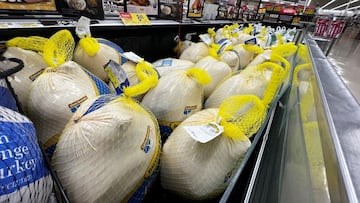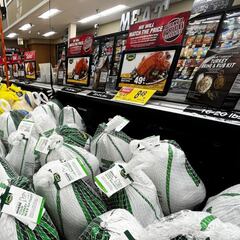How long does it take to cook a turkey? How do I carve, brine and cook a turkey?
Cooking a Thanksgiving turkey just right can be a daunting task, but if you follow a few guidelines and use a little TLC, it will come out great.

There are many ways to prepare your Thanksgiving turkey, every year it seems there is some new fad. Being creative is a great way to impress your guests, but a word to the wise, practice makes perfect.
However, preparing a traditional roasted Thanksgiving turkey doesn’t require a degree from a culinary school, just a little patience, some TLC and following some simple steps while using your common sense.
Also see:
- What are the most popular Thanksgiving dishes?
- Is the post office open on Thanksgiving?
- Black Friday is already underway
- Airline industry prepares for millions to take to sky this week
Thawing a frozen turkey
Most people purchase their turkey frozen, so you’ll need to plan ahead to thaw out your turkey in advance of putting it in the oven. You will want to remove the bag of giblets as soon as possible, especially if you use one of the speedier methods for thawing. And remember, cleanliness is next to godliness whenever cooking with turkey or other poultry.
The USDA recommends thawing your turkey in the refrigerator as it is the safest method. You will need to give your turkey one day for every 4 to 5 pounds in order to thaw completely.
If you’re reading this too late for that, you can use the cold water method or the microwave, but be careful of the latter. For cold water thawing, the USDA advises changing the water every 30 minutes, the same amount of time you will need for each pound of turkey. So if you have a 16 pound turkey you will need 8 hours to thaw it. If you choose to wet brine you turkey, you can start doing so even if it isn’t fully thawed, scroll down to brining for more.
Our #turkey experts are standing by ready to answer any and all turkey cooking questions you have! Let them save you time in the #kitchen so have more time for the fun stuff. #TurkeyTalkLine pic.twitter.com/1QC1SHbiFU
— Butterball (@butterball) November 2, 2021
For Microwave thawing, you will first need to check your owner’s manual for how big a turkey you can put into your microwave oven. Also, what power setting you should use and how many minutes per pound to completely thaw your turkey. You will need to rotate your turkey during the thawing process, regularly checking that you aren’t cooking portions of the turkey. If parts begin to cook, you can let it sit for five minutes before continuing or submerge the turkey in cold water to lower the temperature quickly and halt any cooking that is happening.
If it completely slipped your mind to thaw the turkey or some other force majeure leaves you with a frozen turkey as your only option to save your Thanksgiving feast, fear not. The USDA says that it is completely safe to cook a frozen or partially-frozen turkey. If it is completely frozen, plan to cook the bird at least 50 percent longer and you’ll want a oven food thermometer to make sure the temperature “in the innermost part of the thigh, the innermost part of the wing and the thickest part of the breast,” all register 165º F.
To brine or not to brine…
If you have your thawed turkey ahead of time in the refrigerator, you have a choice of how to prepare your turkey. You will have one to two days to cook your turkey from the time it has completely thawed. This will give you plenty of time to wet or dry brine your turkey should you choose to do so.
What is brining and why might you want to brine your turkey?
Brining is simply salting your turkey ahead of time. Submerging your turkey in a mixture of water and salt, along with aromatics if you want to penetrate your turkey with additional flavors, is wet brining. Rubbing salt, and aromatics if you choose, is dry brining. The process of brining makes the turkey meat more tender and moist, as well as reducing the amount of time needed in the oven for the turkey to be fully cooked.
Wet brining or dry brining
Both options will require plenty of fridge space and some time depending on just how much you want to brine your turkey. Wet brining will require a clean bucket or large pot, big enough to fit the entire turkey in so it can be completely submerged. That it turn will have to fit in your refrigerator, the garage or back porch is not recommended due to temperature fluctuations could allow bacteria to grow. Wet brining allows the salt to penetrate the whole of the bird and the process can take a few hours to a couple days.
Dry brining will require a cooking sheet or tray with raised edges that the turkey will fit comfortably on. The brine mixture, salt and seasoning, is rubbed over the skin of the turkey, which draws the moisture to the surface. There the turkey’s own juices mix with the salt to brine the meat. This method can give the skin a crispier texture when roasted. You can let the turkey dry brine for a few hours to three days, but too long and you will cure the meat. Again, better safe than sorry, use the fridge.
A Sesame Street Thanksgiving, 1974. pic.twitter.com/pNL2MvCBqk
— Muppet History (@HistoryMuppet) November 22, 2021
How to brine a turkey
For dry brining you’ll want to spread sea salt or kosher salt over the skin of the turkey and then place in the fridge on a rack over a tray for a few hours or up to three days. You can also do the same with a prepared mixture of salt and seasoning.
Wet brining you will want to check for different recipes to get ideas but the basic idea is four quarts of water to 1 cup of kosher or sea salt. Add the salt to one quarter of the water you will need to submerge the turkey and bring to a boil to dissolve the salt. If you wish to use aromatics in your brine, put them in to the hot water as well. Let the saltwater mixture cool and then add the remaining water so that it is at room temperature before you dunk your turkey in it. Place the container and turkey in the refrigerator for a few hours or up to 24 hours depending on how much you want your turkey brined. When you pull it out of the brine, dry the skin of the turkey to get a crispier effect.
Getting your turkey ready for the oven
If you chose not to brine your turkey beforehand, giving your turkey a rub down with seasoning and salt prior to putting it in the oven is recommended. So that as the juices begin to flow they mix with the seasoning. Whether or not you brined your turkey, rubbing some olive oil or lard over the skin can add crispiness to it.
Who's with us?! pic.twitter.com/vrZ3NR1cln
— Butterball (@butterball) November 5, 2021
Roasting your turkey in the oven
You will want to pre-heat your oven to 325ºF. Roasting times depend on the size of your bird and whether or not it is stuffed, adding 30 to 45 minutes for the latter. Remember if you brined your turkey you will want to take some time off the total, around 30 minutes. Better Homes and Gardens roasting times never seem to fail. For weights in between those listed, break out the calculator, but expect to have your bird in the oven for at least three hours for a six-pounder, you'll want about half a pound of whole turkey per person.
You will want to baste the turkey with the drippings from the bird on a regular basis, say every 20 to 30 minutes. Watch out that it doesn’t burn on the top. You can use aluminum foil to protect portions of the bird, especially the drumsticks, from burning or getting too dry.
You will want the temperature of your turkey to be 165º at all the innermost points on the bird. If you don’t have a food thermometer, a good rule of thumb is when the legs begin to sag or pull away from the body, it should be perfect. You can also make a small incision the thickest part of the breast and check that the meat is white, no red blood. If you want to be on the safe side you can give it a blast in the microwave once you’ve carved the meat to serve.
Carving your turkey
Everyone has their own technique for carving a turkey, the classic Norman Rockwell image is that of setting the turkey on the table and cutting into the breast with a carving knife and fork. If you have room on the table and aren’t worried about juices flying, go for it. Know though that grease leaves a nasty stain on the wall.
Another option, especially good if you are serving buffet-style, is to pre-carve your turkey before serving. This method has the double benefit that you can present the choice cuts of the turkey on a platter, and the portions that aren’t used right away can be kept warm in the oven for seconds and thirds.
When the meal is all said and done, be sure to clean any leftover meat off the bones before packaging it up in the fridge for a midnight snack, the next day’s, or days’, lunch, dinner, etc.
Are you ready for the #MacysParade? The balloons are giant, the floats are fab, and the performances will be epic. Watch all of the magic 11/25 live from the streets of NYC or on @NBC from 9am-noon in all time zones. https://t.co/20Zc7A5ox9 pic.twitter.com/ARXynWE3Mr
— Macy's (@Macys) November 21, 2021
Making stuffing for your turkey
Stuffing, like brining or carving is up to you. For a simple mix to stuff your bird, warm up some chicken or vegetable broth and add butter. Separately, grab some croutons, you can use some that already have garlic and parsley added to them, but still add fresh if you can, and put them in a bowl. Add salt and pepper as well as other seasonings like thyme, rosemary and/or sage to your liking. Throw some diced celery, onion and carrots into the mix for the standard.
Once the butter has melted, let the broth cool, then add the liquid to your crouton and veggie mix, don’t scald yourself. Add the liquid to your desired texture, note the stuffing will soak up more juices from the turkey as it roasts.
Related stories

What are the most popular Thanksgiving dishes?
Now the messy part, fill the turkey’s cavity with your stuffing. You will want to tie the legs together using cooking string to hold that marvelous treasure inside and keep it out of the drippings you will use for your gravy later. Expect the stuffing to expand, and overflow if you put too much in.
If you want to be more creative, add at your choosing mushrooms, leeks, zucchini and/or turnips. You can also put in prunes, raisin or berries or citrus fruits. For seasoning you can add paprika, sweet preferably, to give a smoky flavor. Bon appetit!

